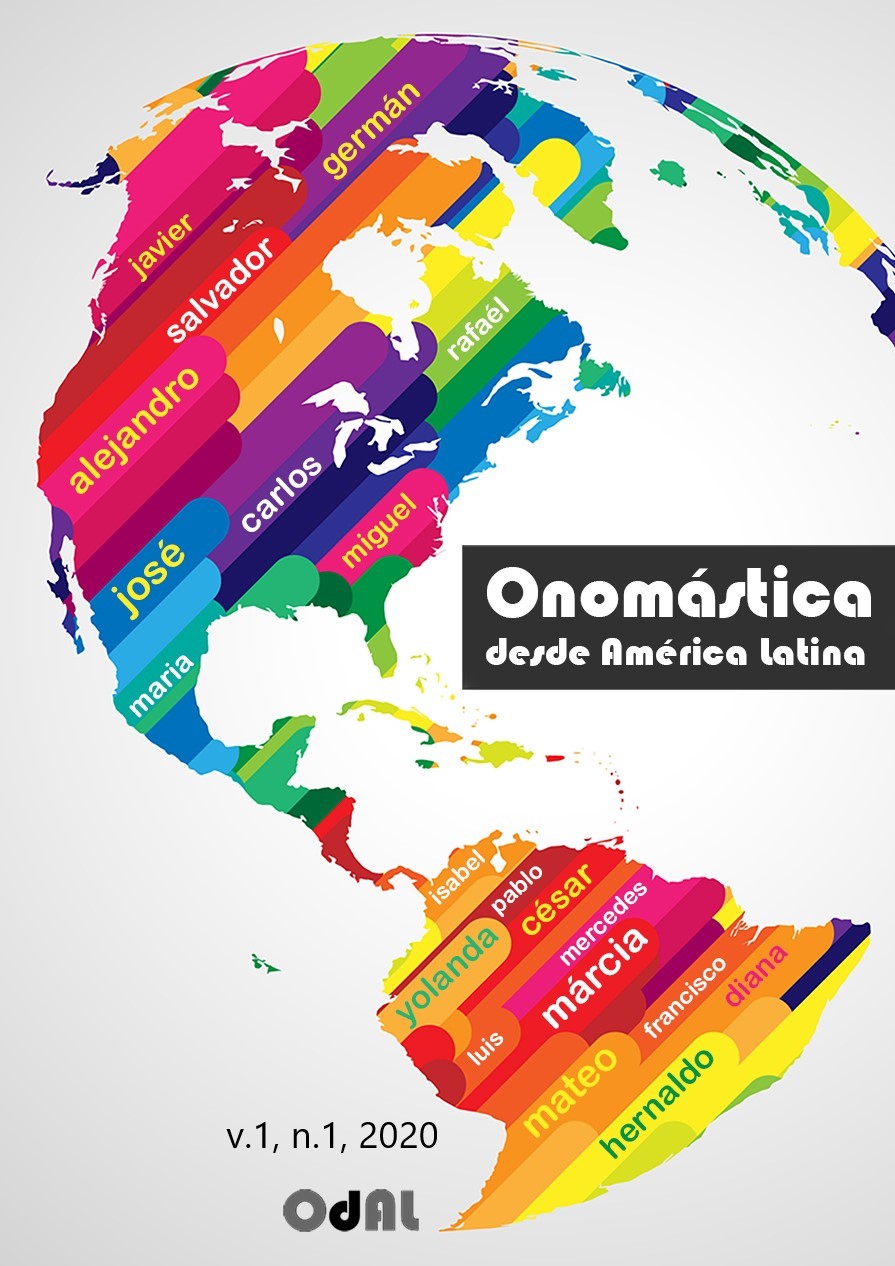A review of the naming profile of the inhabitants of Toledo, Paraná: traditional or innovative?
DOI:
https://doi.org/10.48075/odal.v1i1.24168Keywords:
Onomastics, Anthroponomastics, Nominator profileAbstract
Anthroponyms can be considered, for many, the maximum identity of an individual. Moreover, it is undeniable that, like other factors, people's names are an integral part of the culture of a place, since they reveal the beliefs, desires, and preferences of the named individuals. Thus, the objective of this study is to compare the results of an anthroponomastic survey conducted in the city of Toledo – Parana State - Brazil in 2013 (GRESPAN, 2013), which traced the inhabitants' naming profile from the records between 1954 and 2004, and the data collected in the civil registry of those registered in January 2018 in the same city. It is worth considering that only the names of the subjects will be analyzed. It was sought to answer the following research questions: did the naming phenomena found in the 2013 survey continue to occur in 2018? Do the names considered traditional until 2004 remain in the records 14 years later? Which names registered in 2018 are most repeated? This work is based on the Onomastics, more precisely in the Anthroponomastics, from which postulate Dick (1992) and LópezFranco (2010). To make it feasible, in addition to the data from the 2013 survey, the names of those registered in 2018 were registered at the Civil Registry Office of Toledo, totaling 164 names until January 26th. Of these, 87 are male, 76 female and 1 could not have the gender identified because it is an innovative name. It should be noted that the names of the nominees were not allowed - unlike the 2013 research - and therefore questions that were addressed in the first survey will not be considered here, such as, for example, the motivation to choose a homage to a family member. In addition, the corpus, quantitatively, is not comparable to the initial study, which contributes so that only the analysis of the names is done at the moment. The initial hypothesis is that the choice for religious motivation remains outstanding among subjects in Toledo, since a report published in a city newspaper on April 3, 2016, revealed that the names David and Maria were the most registered in 2015 in the city registry office. These data are in agreement with Grespan's (2013) research, which also recorded Maria as the most frequent name in the analyzed corpus.
References
Besnard, Philippe. (1979). “Pour une étude empirique du phénomène de mode dans la consommation des biens symboliques: le cas des prénoms”.Archives Européennes de Sociologie, n.11:343-351.
Dick, Maria Vicentina de Paula do Amaral. (1992). Toponímia e Antroponímia no Brasil. Coletânea de Estudos. 2ª ed.FFLCH: São Paulo.
Frai, Patrícia Helena. (2016) Motivação para a escolha de um segundo nome na antroponímia Rondonense. 2016. 129 f. Dissertação (Mestrado em Linguagem e Sociedade) - Universidade Estadual do Oeste do Parana, Cascavel.
Gerritzen, Doreen. (2006). “Naming Children in a Globalizing World”, Acta Onomastica, XLVII: 177-184
Grespan, Taiana. (2014). Antroponímia de Toledo-Paraná-1954-2004: aspectos inovadores. 2014. 103 f. Dissertação (Mestrado em Linguagem e Sociedade) - Universidade Estadual do Oeste do Parana, Cascavel.
Guérios, Rosário Farâni Mansur.(1981). Dicionário etimológico de nomes e sobrenomes. 2ª.Ed. São Paulo: Ed. Ave Maria.
López Franco, Yolanda Guillermina. (2010). Un siglo de nombres de pila em Tlalnepantla de Baz. Universidad Nacional Autónoma de México-FES Acatlán-Plaza y Valdés Editores.
Megale, Antonieta Heyden.(2012). O impróprio do nome próprio na Roliúde brasileira. Revista do Curso de Letras da UNIABEU, Nilópolis, v. 3, n. 3, set.-dez.
Sangoï, Jean Claude. (1985). “La transmission d´un bien sympolique: le prénom”, Terrain, n.4, março, 70-62.
Vescovi, Jéssica Paula. (2014) Prenomes e sobrenomes em Palotina-PR e em Maripá- PR: um estudo comparativo. Dissertação (Mestrado em Letras - Área de concentração: Linguagem e Sociedade), UNIOESTE, Cascavel.
Downloads
Published
How to Cite
Issue
Section
License
Copyright (c) 2020 Onomástica desde América Latina

This work is licensed under a Creative Commons Attribution-NonCommercial-ShareAlike 4.0 International License.
Creative Commons Copyright Notice
Open Access Journals Policy
Authors who publish in this journal agree to the following terms:
1. Authors retain the copyright and grant the journal the right of first publication, with the work simultaneously licensed under the Creative Commons Attribution License that allows the sharing of the work with recognition of authorship and initial publication in this journal.
2. Mandatory authorities to assume commitments, for non-exclusive distribution of the version of the work published in this journal (eg, publish in an institutional repository or as a book chapter), with recognition of authorship and initial publication in this journal.
3. Authors are allowed and encouraged to publish and distribute their work online (eg in institutional repositories or on the personal page) at any point before or during the editorial process, as this can generate productive changes as well as increase impact and citation of the published work (See The Effect of Open Access).
Creative Commons License
This work is licensed under a Creative Commons Attribution-NonCommercial-ShareAlike 4.0 International License, which allows sharing, copying, distributing, displaying, reproducing, a whole or parts as long as it has no commercial purpose and is cited by authors and a source.

